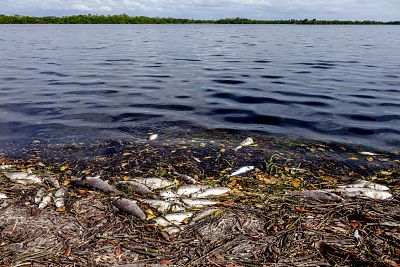Red tide killed thousands of tons of marine life including sea turtles, manatees and dolphins last year.
The toxic algal bloom red tide is back and dead fish are washing up on the shores of southwest Florida again.
Red tide killed thousands of tons of marine life including sea turtles, manatees and dolphins last year.
This year, the algae has washed up in patches, with some beaches almost entirely clear and others covered with dead fish. The phenomenon has not been reported beyond the southwest Florida area this year.
Most of the casualties this time are smaller fish with some instances of sea turtles, manatees and larger sea life. But the bloom appears to not be as severe as the one Florida endured in 2018, which coated the state's west coastand even some of its east coast in dead sea life.
"If I had to rank it compared to some of our more severe blooms like last year, I would say this is more of an average red tide bloom," said James Evans, the director of natural resources for the city of Sanibel Island, Florida.
Red tide on the Florida coast is caused by the algae Karenia brevis, which is toxic and, in concentrations of 10,000 or more cells per liter of water, kills marine life and causes respiratory irritation in humans.
As of Nov. 15, the Florida Fish and Wildlife Conservation Commission found the toxic algae in concentrations of over 1 million cells per liter at 30 locations across about 100 miles of the state's southwest coastline. The agency tracks red tide across the entire state of Florida, issuing reports twice a week.
Blooms start offshore and wash in to the coast, where they can worsen under the right circumstances, including but not limited to high nutrient content from fertilizer-rich runoff.
"We've identified currently over 13 different nutrient sources for these blooms and the ones people focus on are always those near shore nutrient inputs, because that's the one they're most aware of," said Cynthia Heil, director of the Red Tide Institute at the independent, nonprofit marine laboratory Mote Marine.
The algae is unique to the Gulf of Mexico and has been causing fish die-offs for hundreds of years, but last year the city of Sanibel and neighboring Captiva Island lost about $8 million of tourism revenue due to the rancid beach air and more than 850,000 pounds of dead fish.
This year's bloom has yet to reach that level of severity.
Still, Miles Meredith, a charter boat captain based out of Pine Island, said he has to navigate around the patchy bloom.
"I have to travel further to find clean water," Meredith said. "The fish are fine when you find clean water, but we're still dodging it. You never know exactly where it's at."
While Meredith has had to take pains to avoid the algae, he has not seen the same slowdown in business as last year. Other local businesses are staying positive, as well.
"Last year's water quality events definitely impacted revenue, you know, to a point where small businesses had issues as far as looking forward," said Chris Davison, the general manager of the Island Inn, a beachside resort on Sanibel Island. "I believe businesses have rallied and have seen an improvement in the things that have happened since last year."
While local businesses work to recover despite the current bloom, scientists are trying to definitively answer what causes the more severe events.
Scientists know k. brevis is the cause of red tide in Florida, but there is not a lot of consensus on much else.
"If you look at the long term, other red tides around the world, other harmful algae blooms have definitely increased and they have a good record. In Florida, our red tides, people are debating it," Heil said.
There is a state database on red tide that dates back to 1962, but according to Heil it is riddled with inaccuracies and can't reliably be used to answer whether or not red tide has worsened.
For answers to other questions, Mote Marine is spearheading a National Oceanic and Atmospheric Administration-funded $5 million project with other laboratories, universities and the Florida Fish and Wildlife Conservation Commission that seeks to answer both what exacerbates red tide and what causes blooms to cease.
"Last year's bloom was actually two blooms. A '17 bloom that overwintered and was reinforced by a new bloom in '18. There's a potential it's linked via climate change to large storms," Heil said.
Red tide washes ashore almost every year, but the return of the deadly algae after the catastrophic 2018 has left people worried about an ecosystem still in recovery.
"We really cannot afford another fish kill like we had last year," Meredith said. "We just can't. That'd be devastating."












